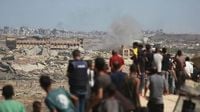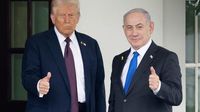United States President Donald Trump has thrown down a dramatic ultimatum to Hamas, demanding that the group accept his 20-point ceasefire plan for Gaza by 6pm Eastern Time (22:00 GMT) on Sunday, October 5, 2025—or face what he described as “all hell, like no one has ever seen before.” The high-stakes deadline, delivered via Trump’s Truth Social platform on Friday, marks the latest twist in a conflict that has left Gaza devastated, displaced its population, and drawn in a host of international actors scrambling for a resolution.
The plan, jointly announced by Trump and Israeli Prime Minister Benjamin Netanyahu at the White House on Monday, calls for an immediate end to fighting and the release within 72 hours of 20 living Israeli hostages held by Hamas, as well as the remains of those thought to be dead. In exchange, Israel would free hundreds of Gazans detained since October 7, 2023—specifically, 1,170 Palestinians detained after the war’s outbreak and 250 others serving life sentences.
Yet, the proposal is far from a straightforward swap. Trump’s plan does not carve out a pathway to Palestinian statehood—a sticking point for many in the region—and places few demands on Israel, whose military campaign in Gaza has, according to the Hamas-run Gaza Health Ministry, killed more than 66,000 Palestinians, most of them civilians, since the war began. The United Nations and human rights observers have gone further, with an independent UN commission declaring in September that Israel’s actions in Gaza amounted to genocide.
Trump’s outline instead sets forth a vision to “redevelop” Gaza into a “deradicalised terror-free zone that does not pose a threat to its neighbours.” Crucially, it requires Hamas to agree to have no role in the governance of Gaza—directly, indirectly, or in any form. In exchange, aid would be allowed into the enclave, where famine has been declared for half a million people owing to a continuing Israeli blockade that has prevented adequate resources from reaching civilians.
“If this LAST CHANCE agreement is not reached, all HELL, like no one has ever seen before, will break out against Hamas. THERE WILL BE PEACE IN THE MIDDLE EAST ONE WAY OR THE OTHER,” Trump wrote in a 329-word post, as reported by BBC and Al Jazeera. He also claimed, “As retribution for the October 7th attack on civilization, more than 25,000 Hamas ‘soldiers’ have already been killed. Most of the rest are surrounded and MILITARILY TRAPPED, just waiting for me to give the word, ‘GO,’ for their lives to be quickly extinguished.”
The plan also proposes the creation of a “Board of Peace,” to be chaired by Trump and including other heads of state such as former British Prime Minister Tony Blair, as a temporary governing structure for Gaza. A separate International Stabilisation Force would bolster Palestinian police and work with Israeli and Egyptian border agents, aiming to maintain security and facilitate the flow of humanitarian aid.
But the proposal has not been universally welcomed. Hamas has yet to officially respond, though a senior figure told Al Jazeera the group is “seriously” discussing the plan but rejects a “take it or leave it” approach. “We are not coming from a position of absolute rejection, but it is also our right to be part of the negotiations,” said Mohammed Nazzal, a member of Hamas’s political bureau. Reports indicate that while some Hamas leaders in Qatar are open to accepting the plan with adjustments, their influence is limited, as they do not control the hostages. The head of Hamas’s military wing in Gaza, contacted by mediators, is reportedly opposed to the deal, according to BBC.
Key stumbling blocks for Hamas include the requirement to hand over all hostages within the first 72 hours of the ceasefire—seen as the group’s most significant bargaining chip—and the lack of guarantees preventing Israel from resuming attacks. Hamas is also seeking a clear timetable for Israeli withdrawal and the right to maintain “defensive” weapons, even if it agrees to dismantle its offensive arsenal. The group has also expressed reservations about an international “peace board” chaired by Trump overseeing Gaza’s governance.
The diplomatic effort has seen a flurry of behind-the-scenes activity. On Wednesday, Trump spoke with Qatar’s Emir Tamim bin Hamad Al Thani about the ongoing talks between Qatar and Hamas. According to Axios, the Emir asked Trump for a week’s extension for Hamas to consider the proposal, citing difficulties in communication between Hamas leaders in Doha and their military counterparts in Gaza. Israeli officials, however, dismissed this as an excuse, claiming that “Hamas leaders inside Gaza are more open to accept the Trump deal than the Hamas leaders in Doha.”
Meanwhile, Arab and Turkish mediators have been pressing Hamas to respond positively, even if they do not agree to all terms. Qatar, Egypt, and Turkey have all urged flexibility, hoping to avoid further bloodshed. Netanyahu, for his part, has managed to negotiate significant edits to Trump’s plan before agreeing to it. Despite the plan leaving open the possibility of a future Palestinian state, Netanyahu has publicly reiterated his opposition, stating, “It’s not written in the agreement. We said we would strongly oppose a Palestinian state.”
The international reaction has been mixed. The Palestinian Authority described Trump’s efforts as “sincere and determined,” while Pakistan’s Foreign Minister Ishaq Dar told Dawn that the published plan had strayed from the original draft presented to Arab and Muslim leaders at the UN. “Changes were made to our draft. I have the record,” Dar said. On Friday, a group of 28 UN experts, including Francesca Albanese, the special rapporteur for the Palestinian territory, blasted the proposal as “reminiscent of colonial practices and must be rejected,” warning that it could “replace Israeli occupation with a US-led occupation” and undermine Palestinian self-determination.
On the ground, the humanitarian crisis in Gaza continues to worsen. More than 750,000 Palestinians have fled Gaza City during the latest Israeli offensive, many lacking shelter and facing severe shortages of food and water. Nearly the entire population has been displaced at least once, according to BBC and the Gaza Health Ministry. Trump, in his ultimatum, urged “all innocent Palestinians immediately leave this area of potentially great future death for safer parts of Gaza,” promising, “Everyone will be well cared for by those that are waiting to help.” Yet, with Israeli forces “tightening the siege” and the UN describing the idea of a safe zone in southern Gaza as “farcical,” the prospects for civilian safety remain grim.
As the Sunday deadline looms, all eyes are on Hamas’s response. Will the group accept Trump’s terms and bring a halt—at least temporarily—to one of the bloodiest chapters in the region’s history? Or will the conflict spiral further, as threatened? For now, the fate of Gaza hangs in the balance, with the world watching—and waiting.


